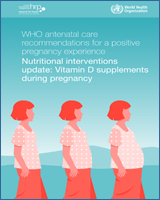Introduction
The World Health Organization’s comprehensive antenatal care (ANC) guideline WHO recommendations on antenatal care for a positive pregnancy experience was first published in 2016 with the objective of improving the quality of routine health care that all women and adolescent girls receive during pregnancy. The overarching principle – to provide pregnant service users with a positive pregnancy experience – aims to encourage countries to expand their health-care agendas beyond survival, with a view to maximizing health, human rights and the potential of their populations.
Recognizing that ANC provides a strategic platform for important health-care functions, including health promotion and disease prevention, 14 out of the 49 recommendations in the WHO 2016 ANC guideline relate to nutritional interventions in pregnancy. In April 2019, the Executive Guideline Steering Group (GSG) prioritized two of these antenatal nutrition recommendations for updating in response to new evidence on these interventions, namely:
Vitamin D supplements during pregnancy
Multiple micronutrient supplements during pregnancy.
Evidence on these interventions was evaluated by a Guideline Development Group (GDG) composed of an international group of experts convened during an online GDG meeting held on 4–5 December 2019. The respective recommendations were updated in accordance with WHO’s living guidelines approach. For consistency and continuity, the GDG, including the chair, comprised the same members as the ANC guideline GDG.
This guideline presents that evidence and updated recommendation on antenatal vitamin D supplements, which updates and does not alter the corresponding recommendation previously issued.
Target audience
The target audience of this updated recommendation is the same as that of the comprehensive ANC guideline and includes national and local public health policy-makers, maternal and child health programme implementers and managers, concerned organizations, professional bodies, health professionals and academic staff involved in health professional training.
Guideline development methods
The updating of this recommendation was guided by the standardized operating procedures described in the WHO handbook for guideline development. This involves: (i) identification of priority questions and outcomes (done as part of the ANC guideline development process); (ii) evidence retrieval and synthesis; (iii) assessment of the evidence; (iv) formulation of the recommendations; and (v) planning for the dissemination, implementation, impact evaluation and updating of the recommendations. The scientific evidence supporting the recommendations was synthesized using the Grading of Recommendations Assessment, Development and Evaluation (GRADE) and Confidence in the Evidence from Reviews of Qualitative Research (GRADE-CERQual) approaches, for quantitative and qualitative evidence, respectively. Up-to-date systematic reviews were used to prepare evidence profiles for the two recommendations prioritized for updating. The DECIDE (Developing and Evaluating Communication Strategies to Support Informed Decisions and Practice Based on Evidence) framework – an evidence-to-decision tool that includes intervention effects, values, resources, equity, acceptability and feasibility criteria – was used to guide the formulation and approval of the recommendations by the GDG.
Recommendation
The WHO technical consultation led to the formulation of one recommendation related to the use of antenatal vitamin D supplements. The GDG had the option to recommend the intervention, not to recommend the intervention, or to recommend the intervention under certain conditions (in specific contexts, targeted monitoring and evaluation, in the context of rigorous research). The GDG experts also provided additional remarks where they considered them necessary. Users of the guideline should refer to these remarks, as well as to the evidence summary, for further information about the basis of this WHO recommendation.
The updated WHO recommendation on antenatal oral vitamin D supplements for a positive pregnancy experience
This recommendation applies to pregnant women and adolescent girls within the context of routine ANC
View in own window
| WHO recommendation on antenatal oral vitamin D supplements |
|---|
| Oral vitamin D supplementation is not recommended for all pregnant women to improve maternal and perinatal outcomes. (Not recommended) |
|---|
| Remarks |
|---|
This recommendation updates and does not alter the respective WHO recommendation on vitamin D supplementation during pregnancy found in the WHO ANC guideline ( 1). Pregnant women should be encouraged to receive adequate nutrition – which is best achieved through consumption of a healthy, balanced diet – and to refer to guidelines on healthy eating ( 2). Pregnant women should be advised that sunlight is the most important source of vitamin D. The amount of time needed in the sun is not known and depends on many variables, such as the amount of skin exposed, the time of day, latitude and season, skin pigmentation (darker skin pigments synthesize less vitamin D than lighter pigments) and sunscreen use ( 3). For pregnant women with suspected vitamin D deficiency, vitamin D supplements may be given at the current recommended nutrient intake of 200 IU (5 µg) per day ( 1, 4). This may include women in populations where direct sun exposure is limited.
|

